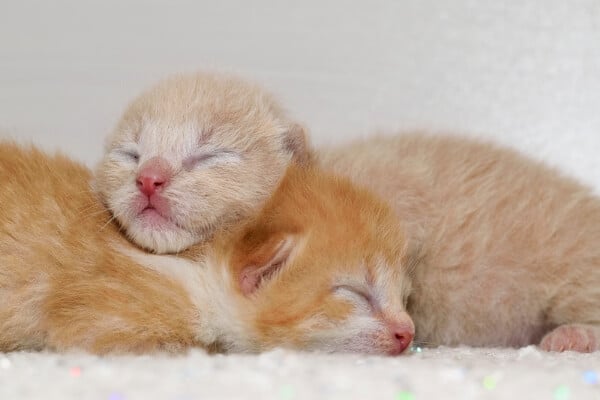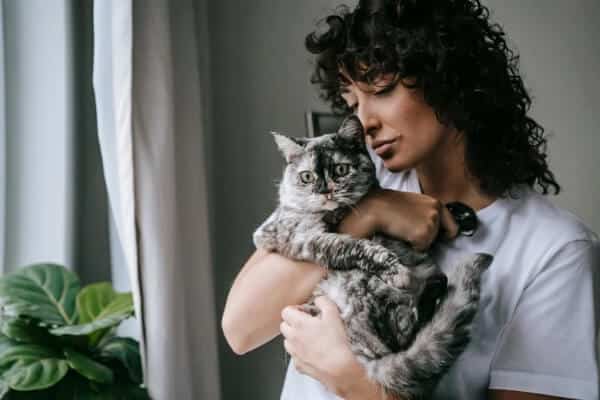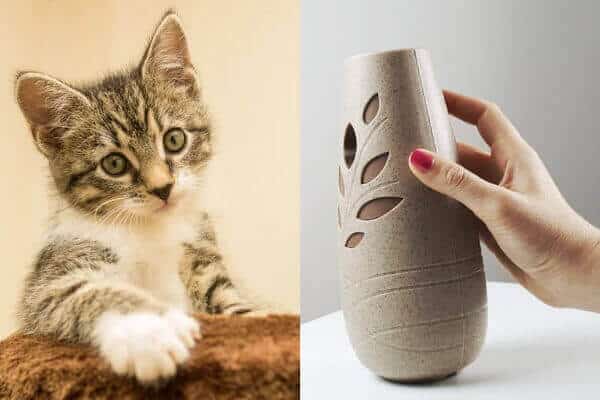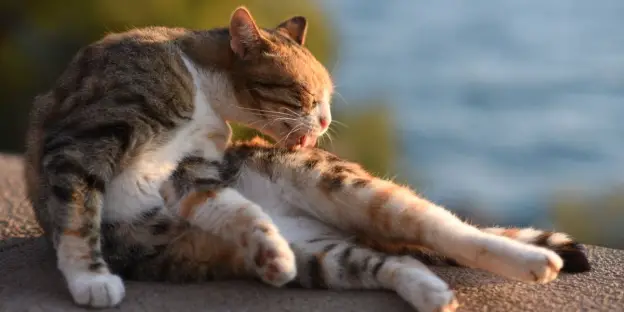Why Is My Cat Staring At Me With His Mouth Open? (6 Possible Reasons)
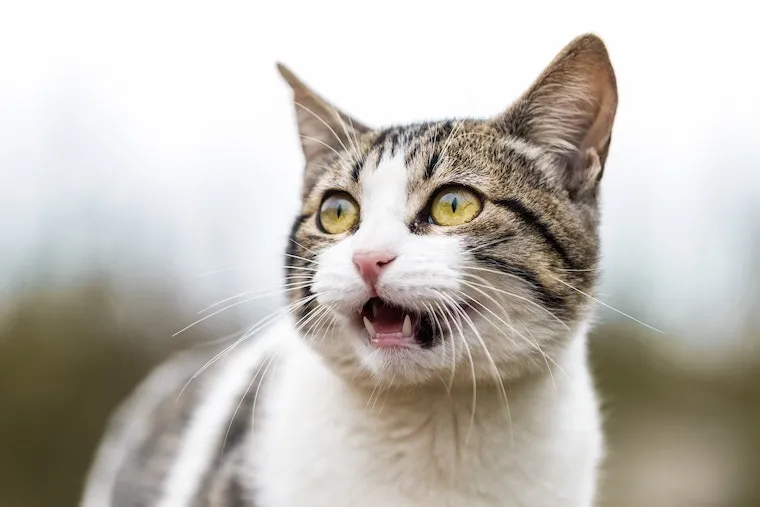
It’s no news that our cats often surprise us at times with unexpected behaviors. There you are, enjoying a quiet moment, when you catch your cat staring intently at you, mouth open. The sight is both amusing and bewildering, leading you to ponder, “Why is my cat staring at me with his mouth open?”
Well, when your cat stares at you with his mouth open, your cat is likely exhibiting Flehmen response, which is essentially their way of Identifying scents by vacuum air into the Jacobson’s organ. Perhaps, panting could account for this open-mouth gesture. Sometimes, it’s a silent meow, a muted call for attention. More concerning reasons could include displays of aggression, dental problems causing discomfort, respiratory issues, or even foreign objects lodged in their throat.
Confronted with this behavior, what should an attentive cat owner do? To begin with, understanding the reason behind the stare is pivotal. Observing their overall demeanor and checking for any signs of distress is a good place to start.
While it’s tempting to constantly react, sometimes it’s best to ignore the behavior to avoid unintentionally reinforcing it. Of course, distractions like play or toys can help divert their attention. But if you suspect health-related issues or if the behavior persists, seeking advice from a veterinarian is essential. At the end of the day, being attuned to your cat’s cues and knowing when to intervene is the key to a harmonious pet-owner relationship.
Jump to Section
1. Flehmen Response To Identify Interesting Scents
The Flehmen response is a common reason why your cat may stare at with an open mouth. It is often dubbed the “Flehmen grimace,” is a behavior exhibited by several mammals other than cats. The Flehmen response is a unique and somewhat comical-looking facial expression where your cat curls back its upper lip, exposing the front teeth, inhales, and then often holds this pose for several seconds.
Cats, among other mammals, have a specialized olfactory organ called the Jacobson’s organ or the vomeronasal organ. It’s situated on the roof of their mouth, behind the front teeth, and connects to the nasal cavity. This organ plays a pivotal role in processing pheromones, which are chemical cues vital for many aspects of animal communication.
When cats encounter a scent that intrigues them, they use the Flehmen response to draw the scent molecules deeper into their nasal passages, allowing the molecules to reach Jacobson’s organ. This “scent-tasting” lets cats gain more information about their environment or other animals. For example, it helps male cats determine if a female is in heat or lets any cat identify territory markings.
:
It’s often observed when cats sniff areas where other cats have urinated. However, cats might also display this behavior after smelling food, shoes, bags, or any object that carries familiar or intriguing odors.
2. Panting Or Open-mouth Breathing
Panting, a behavior often associated with dogs, can occasionally be seen in cats. However, the reasons and implications of this behavior can differ significantly between these two pets.
Cats may pant for various reasons. One of the most benign causes is overexertion. Just like us, after an intense bout of play or activity, cats can get winded. Panting helps them catch their breath, particularly after chasing toys or other energetic escapades. Another common reason is heat. Unlike humans, cats don’t sweat in the traditional sense. Therefore, on hot days or in overheated rooms, a cat might pant to cool down its body.
However, not all panting is due to play or warmth. Sometimes, the reasons can be more concerning. Stress and anxiety are potent triggers. For instance, many cats are not fond of car rides or sudden changes in their environment. In such situations, the unfamiliarity and anxiety can lead to panting.
Yet, when panting occurs without an evident trigger, it’s essential to be attentive. Respiratory issues, such as asthma, feline cold, or bronchitis, can cause a cat to breathe with its mouth open. Similarly, cardiovascular problems can also manifest as panting. Other conditions, including fever, anemia, and certain metabolic disorders, might have panting as one of their symptoms.
3. Verbal Communication: Meowing, Silent Meow, Yowling, Or Hissing
a. Meowing/Silent Meow: Cats use meowing primarily to communicate with humans. Sometimes, after or during a meow, a cat may open its mouth and stare at you. This could be a part of their verbal communication process. Cat meows are often easy to identify but if your cat is not making any sound while looking at you with his mouth open, it might be a silent meow.
b. Yowling: Yowling is a longer, more drawn-out moan or howl. It’s used by cats for various reasons, including discomfort, attention-seeking, or signaling that they are in heat. After a yowl, a cat might pause with its mouth open and stare at you, processing your reaction or waiting for you to respond. This form of vocalization requires your cat to open his mouth.
c. Hissing: Hissing is a sign of fear, annoyance, or discomfort. If a cat hisses and then leaves its mouth open while staring at you, it’s probably gauging your reaction. The cat is on high alert and may be trying to assess whether it should flee, continue hissing, or take another form of action. Just like humans have to open their mouths while talking, it’s no different for a hissing cat.
4. Display Of Aggression
Cats communicate in various ways, and sometimes an open mouth isn’t just about vocalization—it’s about body language. An open-mouth stare in the context of aggression could be a preliminary warning.
Before escalating to hissing or growling, a cat might gape its mouth as a show of discomfort or as a sign telling you to back off. It’s an overt display that they’re on edge. This display might be particularly pronounced if the cat feels trapped or cornered.
The open-mouth stare is a clear signal that they’re prepared to defend themselves if necessary. In scenarios where aggression is more about territory or dominance, the open mouth could also serve as a show of strength or a challenge, especially if faced with another animal or perceived threat.
5. Dental Issues or Mouth Pain
A cat suffering from dental issues or mouth pain may frequently open its mouth as it tries to find relief because closing its mouth causes discomfort. The act of keeping the mouth slightly open could alleviate pressure on sore gums or a problematic tooth.
If you notice your cat staring at you with its mouth open and suspect it might be due to dental issues, other signs to look out for include drooling, bad breath, or a visible reluctance to eat hard foods. Such an open-mouthed stance might be their way of showing distress, hoping their owner will understand something’s amiss. They could be silently imploring you for relief or trying to convey that they’re not feeling their best.
6. Respiratory Problems
When a cat faces respiratory issues, it might resort to mouth-breathing as a coping mechanism. Naturally, cats are obligate nasal breathers, which means they primarily breathe through their noses. If a respiratory problem interferes with this natural process, such as nasal congestion or an obstructed airway, the cat may open its mouth to take in more air. This open-mouth breathing allows the cat to ensure it receives enough oxygen, especially when nasal passages are compromised.
Various health problems can lead to respiratory difficulties in cats. One of the most common is upper respiratory tract infections (URTIs). These infections can cause symptoms like sneezing, nasal discharge, and inflammation. With the nasal passages congested, a cat might find it challenging to breathe through its nose, prompting it to keep its mouth open. Aside from infections, other conditions such as asthma, pulmonary diseases, or even heart issues can present with respiratory distress.
If a cat is staring at you while breathing with its mouth open, it indicates that they are in distress, discomfort, or feeling unwell and are seeking out their owners for comfort or reassurance. The intense gaze could be a way of communicating their unease or seeking help. Additionally, the fixed stare might also indicate heightened alertness due to the distress the respiratory issue is causing.
7. Something May Be Stuck In His Throat
It is important to not rule out the fact that your cat may be experiencing severe discomfort and such is seen when cats have a foreign object stuck in their throats.
Cats are curious creatures and may sometimes chew on or swallow small items, like toy parts, threads, or bones. If one of these gets stuck, it can cause significant discomfort. The cat will naturally try to dislodge the object by coughing, gagging, or pawing at its mouth. However, in moments when it’s trying to catch its breath or gauge the extent of the blockage, the cat might sit still with its mouth open, staring at you to help him or in confusion.
This open-mouthed stare, in this case, is a clear indicator of distress. The cat might be silently seeking help, its gaze directed at its owner in hopes of finding some relief from the sudden and intense discomfort.
What To Do If Your Cat Keeps Staring At You With His Mouth Open?
1. Observe Your Cat’s Behavior
Cats are creatures of habit, so any sudden or unexplained change in their behavior often points to an underlying issue. When you notice your cat staring at you with its mouth open, it’s crucial to be both patient and observant.
Start by looking for patterns. Is there a specific time of day when this behavior occurs? Does it happen after they eat or play, or when they’re in a specific spot in the house? Recognizing triggers can provide valuable insights. For instance, if it happens after eating, there could be dental issues or something stuck in their throat. If it’s during play, they might be too winded or overstimulated.
A cat’s overall demeanor during these episodes can give you more clues. Are they merely opening their mouth, or is there drooling, coughing, or pawing involved? Do they appear relaxed or anxious? For example, if they seem distressed and are drooling or pawing at their mouth, it could indicate pain or discomfort. Conversely, if they appear calm but just sit with their mouth ajar, they might be reacting to a particular scent or exhibiting a Flehmen response.
2. At-Home Inspection And Monitoring
Start with a gentle inspection of your cat’s oral cavity. Using a soft light, like that from a flashlight, can aid in viewing the inside of the mouth. Check for any redness, swelling, or signs of injury. Look at the condition of their teeth. Are there any broken or missing teeth? Signs of yellowing or tartar buildup? Any foreign objects or signs of lesions?
Remember, while some cats might tolerate this, others might be more resistant. It’s essential to be gentle and avoid causing additional stress. If you’re unsure or if the cat is uncooperative, it’s best to consult a veterinarian for a thorough examination.
Monitoring breathing and looking out for any signs of distress: If a cat is breathing through its mouth, it’s often a sign of distress or respiratory issues, as cats primarily breathe through their noses. Watch the rhythm of their breathing. Is it rapid or labored? Do you hear any wheezing or unusual sounds? Also, observe their posture.
A cat that’s hunched over with its neck extended might be trying to clear its airway or get more air. Other signs of distress can include restlessness, pacing, or even hiding. If any of these signs are evident, it’s essential to seek veterinary care immediately.
3. Provide Enrichments Or Distractions For Your Cat
Cats, known for their curious and playful nature, often benefit from a stimulating environment. If a cat is displaying unusual behavior, such as staring with its mouth open, sometimes a change in its surroundings or activities can be a positive step towards normalcy.
A sudden distraction can jolt a cat out of its unusual state. Toys, especially interactive ones, can be a great way to shift their focus. Laser pointers, feather wands, or even simple crinkly balls can pique their interest. Playing with your cat not only offers a distraction but can also strengthen the bond between you two.
A mentally and physically stimulated cat is generally a happy one. Introducing puzzle feeders, climbing structures like cat trees, or even a simple window perch can add layers of enrichment to their environment. Rotate their toys regularly to keep their interest alive.
If feasible, supervised outdoor visits in a safe environment can also provide immense stimulation.
4. Cat Behavior Modification
Before you can address the behavior, it’s vital to understand its root. Why is your cat exhibiting this open-mouthed stare? Is it a response to a stimulus in the environment, a learned behavior, or perhaps a form of attention-seeking? Establishing the cause will dictate the modification approach.
Cats respond well to positive reinforcement. Rewarding them for desired behaviors encourages its repetition. For instance, if your cat stops the staring behavior and behaves as you’d like, reward them with a treat, praise, or petting. Over time, they’ll associate the positive actions with rewards and are more likely to exhibit them.
If the cat begins the open-mouthed staring, try to redirect their attention to a more positive activity. This could be through toys, interactive play, or even a new environment. The idea is to break the fixation on the undesired behavior and offer them an alternative.
It’s essential to approach behavior modification with patience. Scolding or punishing a cat rarely works and often results in fear or increased stress. Instead, focus on encouraging what you’d like to see rather than punishing what you don’t.
For any behavior modification to work, it’s essential to be consistent. Ensure that all family members are on the same page regarding the desired behavior and the methods being employed. Mixed signals can confuse a cat and delay progress.
If you’ve tried multiple strategies and the behavior persists, it might be time to consult a professional. Cat behaviorists or animal behavior consultants have specialized training to address and modify complex behaviors.
5. Consult with a Veterinarian
Often, the best course of action when faced with unfamiliar or concerning behaviors in your cat is to seek the expertise of a veterinarian. They can provide insights that are both rooted in medical knowledge and tailored to your specific cat.
While many cat behaviors can be quirky or harmless, certain signs should prompt immediate veterinary attention. If your cat’s open-mouthed staring is accompanied by labored breathing, drooling, loss of appetite, or any other signs of distress, it’s crucial to consult a vet as soon as possible.
Behavior changes can be the first indication of underlying health issues. It’s always better to err on the side of caution. After all, a timely diagnosis can make a world of difference in treatment and recovery.
Just like humans benefit from routine health check-ups, so do cats. Regular veterinary visits, typically once a year for adult cats and more frequently for kittens or senior cats, can help catch potential issues before they become significant concerns. These check-ups give the veterinarian a chance to assess your cat’s overall health, provide necessary vaccinations, and offer advice on any behavioral or health questions you might have.
Even if your cat seems perfectly healthy, these visits can provide baseline readings on vital signs and blood work, making it easier to detect any changes in the future.
Frequently Asked Questions (FAQs)
Why Does My Cat Open Her Mouth When I Pet Her Head?
When you pet your cat’s head, especially near the base of their ears or around their cheeks, you might be stimulating scent glands located in those regions. As a reaction, your cat might open her mouth to better process or release these scents, especially if they finds the sensation enjoyable or intriguing.
Additionally, the act might also be a part of the Flehmen response, where cats use their Jacobson’s organ (located on the roof of the mouth) to analyze particular scents. However, if the reaction seems consistent and is paired with signs of discomfort, it might be worth consulting a veterinarian.
Why Does My Cat Open His Mouth But Not Meow?
This behavior is intriguing and is referred to as a “silent meow.” Cats have various ways of communicating, and a silent meow can be just as meaningful as one we can hear. Sometimes, it’s a gesture of trust or contentment. At other times, it might be a subtle way for the cat to communicate without alerting other creatures.
Some older cats or those with past injuries might naturally produce softer or even silent meows. If there’s a sudden change in the way your cat vocalizes, especially if it seems to be struggling or in distress, it’s a good idea to consult with a vet.
Why Does My Cat Open Mouths When Stressed?
Cats may open their mouths when stressed due to increased respiratory demands. Stress or anxiety can lead to faster breathing, and if the nose doesn’t provide enough airflow, a cat might resort to mouth breathing. An open mouth can also be a sign of heightened alertness where the cat is trying to gather more information from its surroundings, possibly through scent.
It’s essential to recognize and address the sources of stress in your cat’s environment to ensure their well-being
Why Does My Cat Open His Mouth When Playing?
Play is an essential aspect of a cat’s life, often mimicking their natural hunting behaviors. When a cat opens its mouth during play, it might be gearing up for a playful “bite” on a toy. Intense play can sometimes lead to a cat getting very excited, which might make them pant or breathe with an open mouth. Play can also activate the cat’s keen sense of smell, and just like with petting, the cat might be trying to process certain scents by opening its mouth.
Read related posts about

